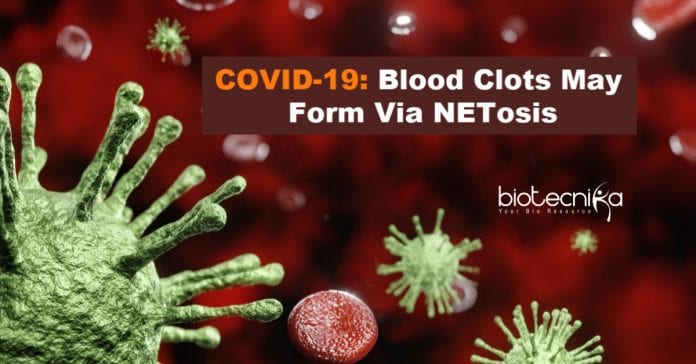COVID-19: Blood Clots May Form via NETosis
Patients with COVID-19 who endure dangerous life-threatening complications such as blood clots and inflammation also experience dysregulated NETosis – Cell death process that produces neutrophil extracellular traps (NETs), extracellular webs of DNA, and also toxic substances that capture and eliminates pathogens. Nonetheless, the neutrophil extracellular traps might interact with platelets and develop microthrombi that add to acute respiratory distress syndrome (ARDS).
The interrelationship between the severity of COVID-19 and excess NETs has been made clear by scientists at the University of Utah Health, Weill Cornell Medicine, Cold Spring Harbor Laboratory, and PEEL Therapeutics. Additionally, these scientists report that the neonatal NET-Inhibitory Factor may obstruct the NETs induced by COVID-19.
This outcome of the research is published in the journal Blood titled “Neutrophil Extracellular Traps Contribute to Immunothrombosis in COVID-19 Acute Respiratory Distress Syndrome”. The research paper stated that blood samples were collected from 33 hospitalized individuals, and autopsy tissue samples were also collected. Additionally, the study defined how the blood and tissue samples were examined for biomarkers of NET development including biomarkers such as selected cytokines, platelet factor 4, RANTES, and plasma myeloperoxidase – DNA complexes.
The author of the study said that
the study demonstrates a robust connection between NETs and the extent of respiratory disease in COVID-19. Using endotracheal intubation the highest levels of circulating NETs are measured in COVID-19 people and report for the first time the infiltration of platelet co-localization with citrullinated histone H3 positive neutrophils most likely undergoing NETosis in the pulmonary microthrombi of the dead COVID-19 patients.The scientists identified that biomarkers of NET development were a lot more abundant in individuals who needed ventilation, and highest in the 3 research study participants who eventually died from COVID-19. In the lab studies, neutrophils from COVID-19 patients churned out extremely high levels of NETs. When the healthy neutrophils were subjected to plasma from individuals with the disease, they acted the same way. In the autopsy samples, the scientists found tiny clots of tangled NETs and blood platelets scattered through the tissue – known as microthrombi.
Elizabeth Middleton, MD, the first author of the study and a critical care specialist at the University of Utah Health said, this research discloses a potential mechanism for lung injury in COVID-19 that had not previously been recognized as a possible target for the therapy.
Christian Con Yost, MD, Co-senior author of the study, and a physician-scientist at U of U said NET levels in the blood might aid in predicting disease severity and fatality in COVID-19.
Additionally, the researches reported that a small protein present in the newborns’ umbilical cord blood called neonatal NET Inhibitory Factor, silences the hyperactive NET reaction in WBC treated with plasma from COVID-19 patients. Joshua Schiffman, MD, co-senior author of the study, University of Utah Health scientist, and CEO of PEEL Therapeutics said, this peptide is believed to safeguard children from dangerous inflammation early in life. Currently, his firm is reviewing whether the protein could become the basis for scientific therapy.
Schiffman clarified that natural therapeutics are present in the blood of the newborns to protect against these same inflammatory events that we assume could be killing COVID-19 individuals. This approach to stop NETs may be more efficient with much less adverse effects than some other medications being tested now in patients with COVID-19 in which the whole immune system of the body is blocked.
Yost, whose laboratory at the U of U Health discovered neonatal NET Inhibitory Factor in 2016 said the NET-inhibitory protein may obstruct exaggerated NET development in patients with COVID-19 however, further studies are needed. He also indicated that to identify whether NETs could become a biomarker for COVID-19 severity, further studies are required. We assume that morbidity and mortality in COVID-19 could be due to exaggerated NETs.
Mikala Egeblad, Ph.D., co-author of the study and a cancer researcher from CSHL said, the ramifications of the new NET findings extend beyond COVID-19. She added excess NETs are created in various other viral diseases. Additionally, what we are finding out in COVID-19 might help us recognize basic properties in cancer and various other diseases as we know that clotting is a significant cause of death in individuals with end-stage cancer.
COVID-19: Blood Clots May Form via NETosis
Author: Sruthi S






























